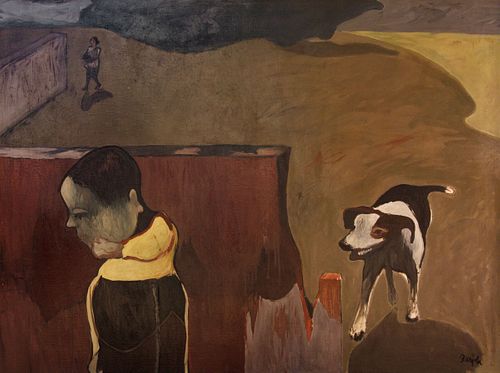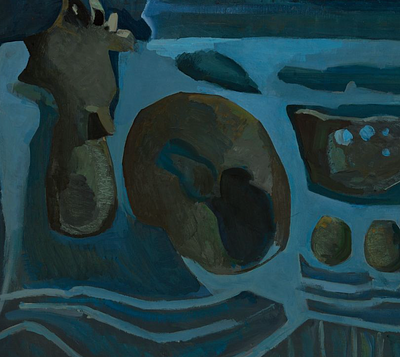JUAN BARJOLA (Torre de Miguel Sesmero, Badajoz, 1919 - Madrid, 2004). Untitled. Oil on canvas.
Lot 75
About Seller
Setdart Auction House
Carrer Aragó 346
Barcelona
Spain
Setdart Subastas was born in 2004 and is currently the first online art auction in Spain with solidity, prestige and reliability guaranteed by our more than 60,000 users. Setdart has a young, dynamic and enterprising team ready to successfully manage the purchase and sale of art works through custom...Read more
Estimate:
EUR€20,000 - EUR€25,000
$21,505.38 - $26,881.72
Absentee vs Live bid
Two ways to bid:
- Leave a max absentee bid and the platform will bid on your behalf up to your maximum bid during the live auction.
- Bid live during the auction and your bids will be submitted real-time to the auctioneer.
Bid Increments
| Price | Bid Increment |
|---|---|
| EUR€0 | EUR€10 |
| EUR€200 | EUR€25 |
| EUR€500 | EUR€50 |
| EUR€1,000 | EUR€100 |
| EUR€3,000 | EUR€200 |
| EUR€5,000 | EUR€500 |
| EUR€10,000 | EUR€1,000 |
| EUR€20,000 | EUR€2,000 |
| EUR€50,000 | EUR€5,000 |
About Auction
By Setdart Auction House
Jul 27, 2021
Set Reminder
2021-07-27 08:00:00
2021-07-27 08:00:00
America/New_York
Bidsquare
Bidsquare : CONTEMPORARY AND ACTUAL ART
https://www.bidsquare.com/auctions/setdart-auction-house/contemporary-and-actual-art-7261
Setdart Auction House sofia@setdart.com
Setdart Auction House sofia@setdart.com
- Lot Description
JUAN BARJOLA (Torre de Miguel Sesmero, Badajoz, 1919 - Madrid, 2004). Untitled. Oil on canvas. Signed in the lower right corner. Measures: 80 x 130 cm. Belonging to the current of the representative expressionism, Juan Barjola is one of the most outstanding Spanish painters of the second half of the 20th century. Already as a child his love for drawing is manifested, which will lead his parents to guide him on the path of art. At the age of fifteen Barjola arrives in Badajoz to begin his training, and enters the School of Arts and Crafts of the city. Fully committed to his incipient career, in 1943 he moved to Madrid, where he first studied at the School of Arts and Crafts on La Palma Street and, later, at the San Fernando School of Fine Arts. At the same time, he furthered his training at the Prado Museum, where he copied Velázquez and interpreted Goya, Brueghel, El Greco and Bosch. During this period, which ended in 1950, Barjola produced a series of academic works of a naturalistic style, with themes taken from family life, suburban characters and other genre scenes. Around 1950 he began a new stage of post-cubist style, a prevailing trend in Madrid at that time due to the influence that Daniel Vázquez Díaz exerted on a whole generation. During these years Barjola would develop faceted images, with flat treatment and bluish and cold colors. At the same time he began to develop a new, more constructive stage, marked by earthy colors. In 1957 Barjola made his individual debut at the Abril gallery in Madrid, and that same year he held two more personal exhibitions in Brussels, at the Theatre and Vallvora galleries. He then began a brilliant exhibition career that would take his work to Europe, Japan, the United States and Latin America. Around 1958 he began a short but intense period in which he experimented with a language of abstract tendency in which the pictorial matter assumed the leading role in the painting. His work will now be marked by thick and sumptuous impastos of sordid and dark colorations, which form abstract and organic still lifes. It is the moment of apogee of the material abstraction led by Tàpies from Barcelona. A year later, and without disappearing the thick impastos, the organic stains begin to be resolved in human embryos, the result being a return to figuration in line with the international trend initiated by Francis Bacon. Barjola thus became the main Spanish representative of the New Figuration. In 1960 he received a grant from the Juan March Foundation which allowed him to travel to Paris and Belgium, and in 1963 he was awarded the Eugenio D'Ors Medal by the critics. That same year he exhibited at the Dirección General de Bellas Artes, and shortly after he was awarded the National Drawing Prize at the National Exhibition (1968). Towards 1964 his work undergoes a new evolution, marked by the paintings of Velázquez, Goya and El Greco. Thus began the Golden Age of the painter, with paintings transformed by the appearance of the human figure, three-dimensional space, natural light and the open air. The thick impasto disappears and his language becomes more fluid, while his colors acquire brightness and luminosity. At the same time, Barjola created a series of works of brutal expressionism and great visual power, linked to the themes of violence and war. However, by 1972 his painting began to leave behind this conceptual weight to open up to a more purely plastic experimentation, in which form, composition and color became the protagonists. This change leads, in the eighties, to a painting marked by a decorative sense and a lighter lyricism and optimism. All the drama of his work disappears, and the paintings become celebrations of light, color and movement.
- Shipping Info
-
In-house shipping available. Please inquire at admin@setdart.com.
-
- Buyer's Premium



 EUR
EUR CAD
CAD AUD
AUD GBP
GBP MXN
MXN HKD
HKD CNY
CNY MYR
MYR SEK
SEK SGD
SGD CHF
CHF THB
THB














